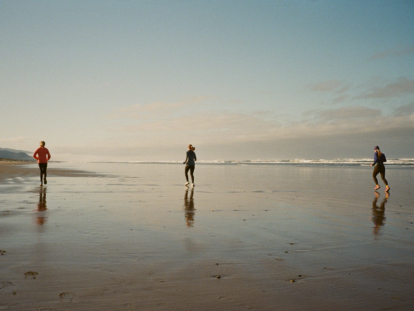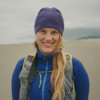Running the Coast
All photos by Kiko Sweeney
My family runs.
It’s something my mom, dad, sister and I all share. Most years while I was growing up, our family made an annual trek from Los Angeles to the coastal city of Manzanita, Oregon, (population 454) where my grandpa built a cabin in the 1950s. With extended family in the Pacific Northwest, our summer trip to Manzanita was an annual opportunity to connect with cousins, aunts, uncles and grandparents. The obvious activity while in Manzanita was to play on the sand all day long. Some of my earliest memories are of running on the Oregon Coast, sprinting barefoot across wet, dense sand at low tide, with cool grains wedged between my toes and icy waves washing over my feet.
Even now, mornings at the beach cabin come with a routine. Mom and Dad get up early. He makes drip coffee and first breakfast. She stretches. My sister Kyra and I make more coffee, usually reusing Dad’s grounds. The local NPR station is on. Upon muting that, we hear the sound of crashing waves. Dad and I gather at the oversized windows to watch the clouds hanging over the Pacific and all the variations of weather that move across the coast.
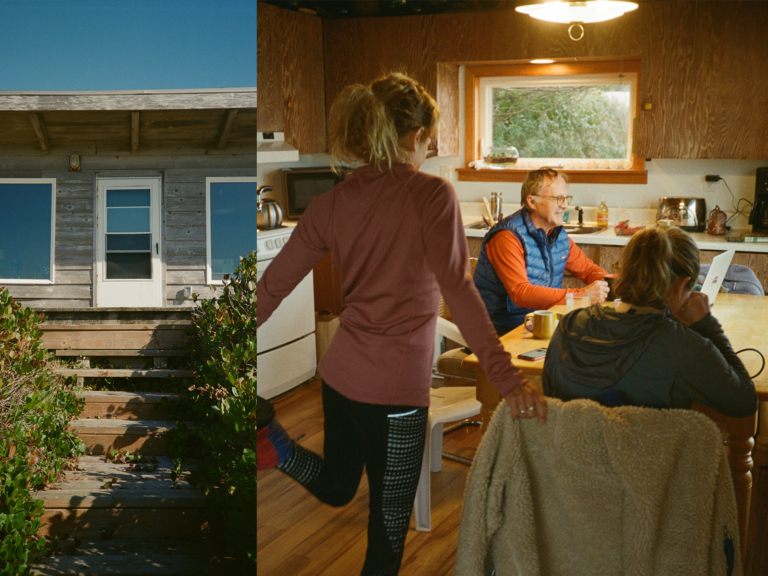
Left: An overgrown path from sand dunes leads to the back porch of a weather-worn family cabin near Manzanita, Oregon.
Right: Going through pre-run rituals, the Sweeney-Mathews family sip coffee and stretch in the cozy family cabin. Patagonia Product: Capilene Crew Neck, Airshed Pro Pullover, Down Sweater Vest
Eventually, we pull on sandy running shoes, still wet from the previous day, and head out the door.
Mom guides Kyra from the house down a beach-access trail that ends with a faded orange caution sign before reaching the sand. Kyra is blind. She was born with a genetic disorder that prevents light from reaching her retinas. Running for her isn’t one of those “against the odds” narratives that so often get attached to athletes with disabilities. It’s just something she does to relieve some pressure as she starts her career as a lawyer.
Kyra is not alone in sharing her disability identity in our family. I am an ally to Kyra while I also have a disability of my own, as someone who lives with chronic migraines. Our parents are both managing long-term injuries and pain, hoping for their current ailments to heal. However, they accept that a part of aging is disability and learning how to do the things they love differently.
Our family has thought a lot about disability, what it means and how it defines us. There are official definitions that come with access to critical support systems for people with disabilities. There is also the reality of living with a disability every day and the adaptations that result. Mom and Dad, for instance, have reconsidered lifelong practices.
Being a runner helps me understand my migraines as a disability. It’s the recognition that my migraines stop me from doing something that I would otherwise be doing. On days when my head hurts, I can’t run. Instead, I skip that day, week or month in order to keep the pain from getting worse, holding a little grace for myself in those moments.
Kyra’s relationship with her disability and running also continues to evolve. Running has not always been pleasant or accessible for her. In P.E. class as a kid, she would sometimes worry that no one would run with her or that they’d only be running with her out of obligation. “As an adult, I discovered that running could be social,” she says. “Having a family of runners was a really good thing for me.”
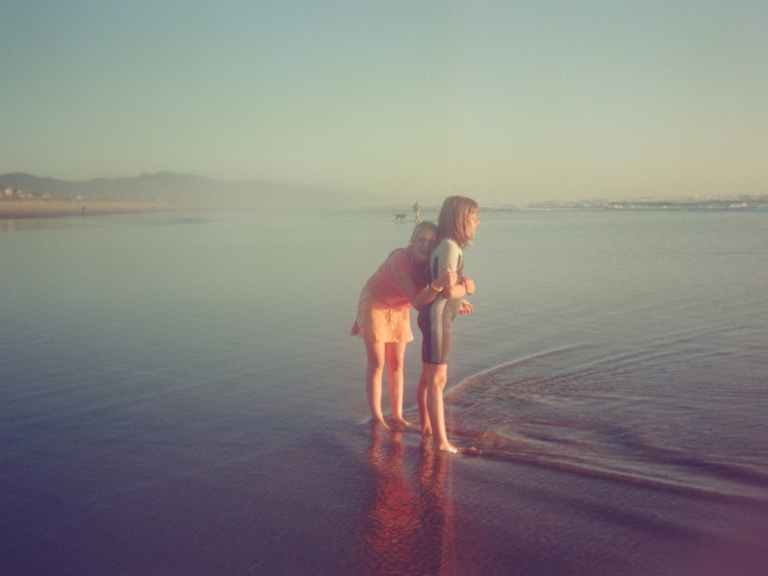
Older sister Kiko Sweeney embraces younger sister Kyra, both drenched from playing in the waves near Manzanita Oregon.
At home in Boston, she runs on a treadmill or with Achilles International, a network of running groups that sponsors regular runs for people with disabilities. A guide helps her navigate around obstacles while the pair stays connected by a tether. Our family built a homemade tether out of two vintage aluminum carabiners—formerly my dad’s from back when he was climbing around the world in the ’80s and ’90s—connected by a short blue bungee cord, basically like an old quickdraw.
At the coast, we bring the tether but let it go once we hit the expanse of compact sand at low tide. “Growing up, it was very freeing [to run on the beach],” says Kyra. “I knew that I would be safe. The only thing I’d probably hit is the water. Maybe I’d run into Kiko, but she’d probably live.”
We follow the path past head-high dunes that seem to get bigger every year. They’re covered in beach grasses which sway ever so slightly in the morning breeze.
Dad remembers us sprinting as kids, with the wind in our faces and salt spray in the air. “Breezes, water, big open sky—the beauty of being on the beach and feeling free to run. It was a joy to watch you girls,” he says.
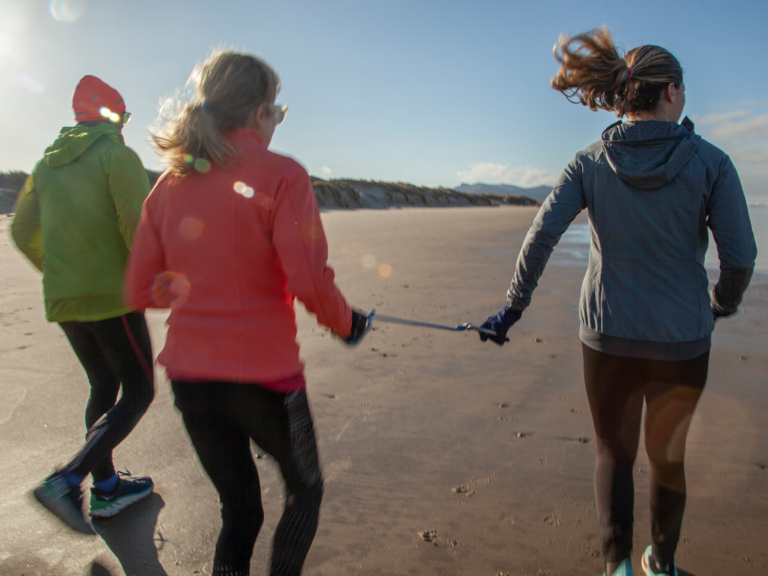
Runners Barbara Mathews, Rob and Kyra Sweeney move fast past sandy dunes and distant waves, Barbara guiding blind daughter Kyra, near Manzanita, Oregon. Patagonia Product: Airshed Pro Pullover, Endless Run Tights, Vintage Capilene Gloves, Nano Air Hybrid Light Jacket, Houdini Jacket
Now, we’re past the winter’s tidal deposits of driftwood. The evergreen-covered Neahkahnie Mountain looms to the north, holding thick clouds and framing Manzanita’s expansive beach. It’s cold today and humid. Light mist rises from distant crashing waves.
We turn south, fanning out in a line, perpendicular to the water’s edge. But our formation quickly devolves. Kyra relinquishes the tether and branches off from the group, trending toward the outgoing tide. For Kyra, being at the beach is a rare opportunity to run independently. “Alongside the ocean, I can use the sound as a guide to keep going in a straight line,” Kyra describes. “If I’m racing toward the ocean, that sound is my finish line.”
Mom and Dad transition to a fast walk. I stop to search for whole sand dollars and take a few sips of water.
Since childhood, Mom and Dad have modeled running as a way to manage stress, stay healthy and have fun. “[Running is] so much of my identity … I thought not being able to run would be the end of the world,” my Mom told me. But when forced to not run while recovering from surgery, Mom found different ways to get outside. Out here today, Mom keeps track of time, sometimes running literal circles around the rest of us.
One of the many joys of running at the beach is that certain necessary adaptations, like Kyra’s use of a guiding tether or Mom and Dad’s need for soft running surfaces, become less relevant. It’s a place where we simply get to celebrate the freedom to move, as runners and as a family.
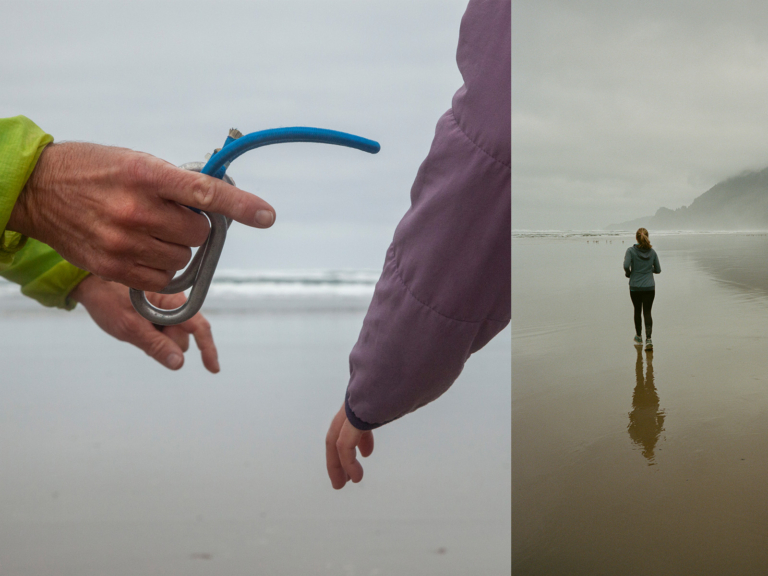
left: Rob Sweeney reaches out to daughter Kyra Sweeney with a tether used to guide Kyra, who is blind, on the last leg of a morning run near Manzanita, Oregon. Patagonia Product: Houdini Jacket, Pack In Hoody
Right: Using the sound of incoming waves to navigate, blind runner Kyra Sweeney strides into the horizon on a winter morning run near Manzanita, Oregon. Patagonia Product: Airshed Pro Pullover, Endless Run Tights
About 3 miles in, we reach a jetty indicating the end of the beach, signaling that it’s time to turn around. The ebbing tide widens the already expansive beach, providing more space to explore on the way home. Dad finds a whole sand dollar. Kyra and I race toward the water’s edge, giggling and screaming like we did when we were little, finding deposits of tidal pools and splashing through the icy water, soaking our socks and shoes.
Finally, we reach the dunes in front of our cozy, weathered cabin. Mom guides Kyra back through the notches in the sandy mounds that swell and ebb over the years. I’m grateful for the time we spend running as a family on the wide-open sandy beaches of the Oregon Coast, celebrating what isn’t in the way.
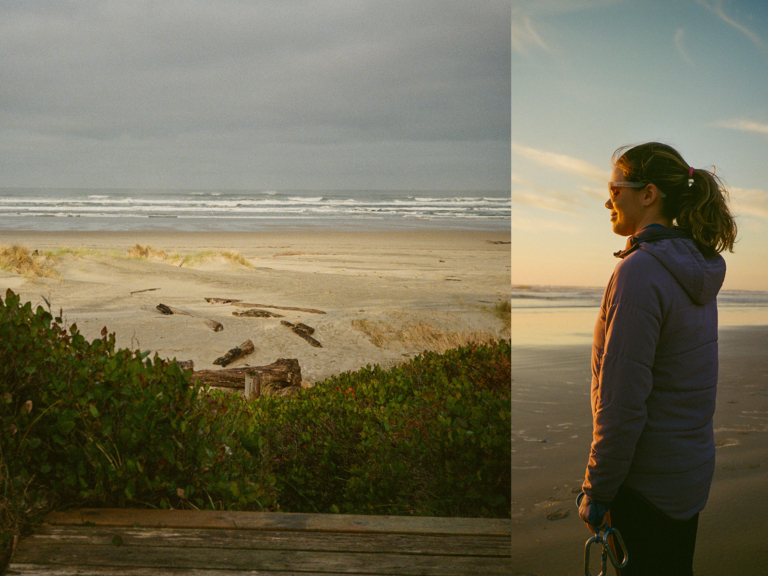
Left: On a winter morning, sun breaks through thick morning fog on the sandy beaches of Manzanita, Oregon.
Right: Blind athlete Kyra Sweeney basks in rays of setting sun on the Oregon Coast. She holds a tether used as a guiding device while running. Patagonia Product: Pack In Hoody
Author’s Note: In this article, I use person-first language to describe someone with a disability. However, I honor that individuals within this vast community have the agency to choose how they identify, which can fluctuate over time. Don’t know how a loved one identifies? Respectfully ask, bringing your own education and an open heart to the conversation.
